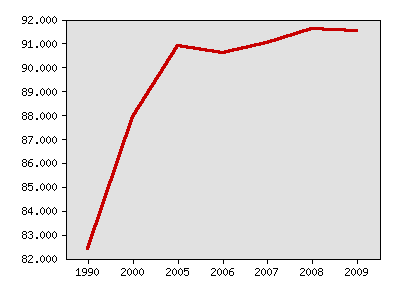Indicator 39: High School Education


Rationale: A high school education is the minimal entry-level requirement for many jobs. The educational attainment of the workforce is important both for the state’s economic development and the financial well-being of individuals.
About this indicator: The percentage of Minnesotans ages 25 and older who have graduated from high school rose from 82.4 percent in the 1990 Census to 90.1 percent in the 2000 Census. The American Community Survey shows a 2009 rate of 91.5 percent, not statistically different from the 2008 rate.
Percent of population ages 25+ with at least a high school diploma

| Year | Data |
|---|---|
| Percent of population ages 25+ with at least a high school diploma, U.S. Census Bureau | |
| 1990 | 82.4% |
| 2000 | 87.9% |
| 2005 | 90.9% |
| 2006 | 90.6% |
| 2007 | 91% |
| 2008 | 91.6% |
| 2009 | 91.5% |
For comparison: Minnesota is statistically tied for first with four other states in the percentage of adults who have completed high school, according to the 2008 American Community Survey. The national average was 85.3 percent.
Things to think about: Much of the increase in educational attainment is traceable to the replacement of older generations who typically had less education. Educational attainment among younger adults has shown little change.
Technical notes: The data includes people who have received a GED or other high school equivalency certificate. In 2008, 11 percent of Minnesotans who had graduated from high school but not advanced to college had received their diploma via a GED or similar certificate.
Sources:
- U.S. Census Bureau, Decennial Census and American Community Survey, http://www.census.gov/
Local data:




